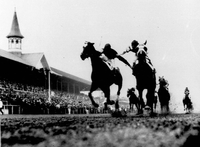2006 News
August 17, 2006
Running Form Analysis of Japanese Triple Crown Horse (Deep Impact)

Japan Racing Association, Equine Research Institute, Sport Science Division, T. Takahashi and A. Hiraga
Deep Impact, undefeated Japanese triple crown winner in 2005, was said that his running form was different from the other strong race horses, because ace jockey of Deep Impact commented that he ran as if he was flying in the air, and an abrasion of hindlimb shoe was smaller than other strong horses. The suitable running form in each horse is probably different with conformation. However, we think that there may be some common characteristics in running form of faster race horses. The purpose of this study is to describe the characteristics of fast race horses by analyzing the running form of Deep Impact with high-speed video. High speed video of the Kikuka Sho race (Japanese St. Leger, JPN G1, at Kyoto race course, distance; 3,000 m, track type; turf, track condition; firm, 3 years old Colt & Filly, Oct. 23, 2005 ) was taken at a rate of 250 flames/s. The high speed video system was set in a left lateral position at about 100 m before the goal with field view about 16 m wide. The speed of Deep Impact was 17.8 m/s (average 16.1 m/s), that was fastest in all measurable horses,the stride frequency, 2.36 strides/s was third (average 2.28 /s) and the stride length, 7.54 m was longest (average 7.08 m). Overlap time (period of time that 2 legs were contacting the ground) of Deep Impact was shorter than average value (Fig. 1). A ratio of overlap time to stride duration of Deep Impact was 8.5 %, while average value was 17.1 %. Shorter overlap time is common characteristic of Secretariat1. Diagonal (between leading hindlimb and trailing forelimb) and airborne step length of Deep Impact was longer than average value1(Fig. 2). Longer diagonal step length is also common characteristic of Secretariat1. These common characteristics to Deep Impact and Secretariat may be essential characteristics of superior horses.
Reference
1. Pratt GW, Jr., O'Connor JT, Jr. A relationship between gait and breakdown in the horse. Am J Vet Res 1978;39:249-53.
Fig. 1 Gait diagram at about 100m before the goal of the Kikuka Sho
Fig. 2 Comparison of hind step, diagonal step and fore step length at about 100m before the goal of the Kikuka Sho
* JRA Equine Research Institute website: http://www.equinst.go.jp/EG/f00.html
* 2005 Kikuka Sho Race Replay: High : Low 
Result* Result of 2005 Kikuka Sho







